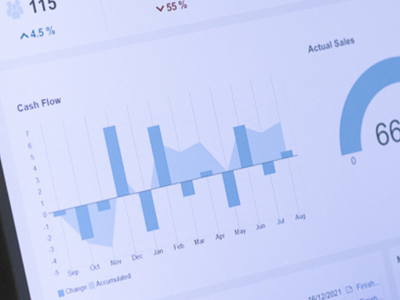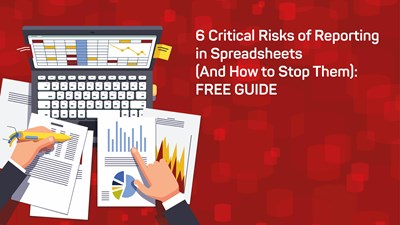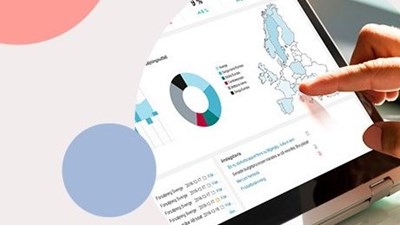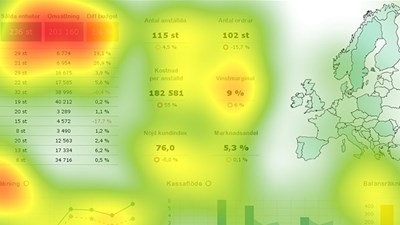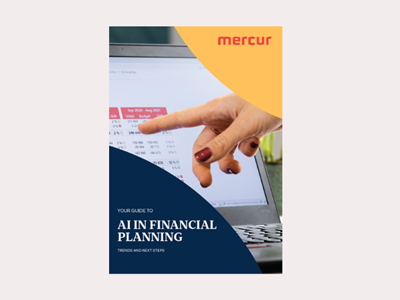.jpg?TS=638959538618053376)
Why Flexible Budgeting Is the Smartest Move for 2026
Creating a flexible budget provides greater opportunities for changes. Unlike traditional budgets, which are fixed, flexible budgets adjust to changes in response to market demands, sales, production volume or other measurable business activity. The ability of the budget to adapt to changing conditions allows for more accurate forecasts and better use of financial resources.
If you wonder why sales numbers differ from expected and how it can impact the overall financial health, this is where flexible budgeting plays a crucial role. In this article, you will learn how to create a flexible budget to maximise your profits, the importance of it and simple and practical steps for implementation.
What is Flexible Budgeting?
A flexible budget is a budgeting process that allows changes to real-time outcomes and performance. The budget is a comprehensive plan that outlines resource allocations to maximise profit in a certain period of time. All budgets are created based on previous assumptions. But when there are changes in the sales activity, a flexible budget can provide real-time information about the current financial situation based on the latest business activities.
It is primarily used to identify costs and expenses that vary in activity levels and calculate the expected budget for each activity. For instance, if a bakery produces cakes and the cost of ingredients per cake drops when buying flour and sugar in bulk, the flexible budget would adjust to show reduced material costs at higher production levels. This allows the bakery to plan more accurately for periods of increased demand. As production rises, the flexible budget reflects these economies of scale, giving a clearer picture of expected profits.
Pros and Cons of Flexible Budget
When creating the budget for the next period, organisations tend to use a more flexible budget to adapt to changes. However, you should understand how it works, as well as its main advantages and disadvantages, so you can effectively implement it within your organisation.
Benefits of Flexible Budgeting
The primary purpose of the flexible budget is to provide accurate financial information about each activity that has been changed. Other benefits for the organisation are:
Adaptability - Budgets are typically created on assumptions that may sometimes be inaccurate. The flexible budget adapts to any kind of change, making the organisation react faster to the market and make the budget more relevant and accurate.
Better Performance Analysis - More accurate variance analysis helps companies better understand the actual performance of their current activities. This method shows whether cost changes come from activity levels or management efficiency.
Strong Strategy - Businesses can make more informed decisions based on accurate and up-to-date financial information, enabling them to forecast future outcomes with greater confidence.
Better Cost Control - Because it can adjust to different financial plans and provide a more realistic financial picture, it allows businesses to control their costs more effectively. As a result, they can respond quickly to changes and make better performance evaluations.
A flexible budget helps identify where expenses can be reduced to protect profits. It also shows what actions are needed based on current sales levels, keeping your decisions aligned with business activity.
Challenges With Flexible Budgeting
Businesses may face certain limitations when handling flexible budgets, such as:
Complexity: Unlike static budgets, flexible budgets can be more complex to implement, requiring more time and resources.
Data Issues: Maintaining a flexible budget requires a large volume of data. Without a proper data management system, this leads to inaccurate budget projections.
Forecasting Dependency: The flexible budget relies on accurate forecasts of future activities. Inaccurate predictions can result in unrealistic forecasts and poor financial planning.
Organisational Factors: Shifting to flexible budgeting requires more discipline and precision. Some employees may find it challenging to adapt to a new budgeting system that leads to a loss of cost control and accountability.
All these limitations can be successfully overcome with good team organisation and planning. The whole process doesn’t need to be scary; on the contrary, it will make you more efficient and productive, which in turn impacts the overall financial health.
3 Common Flexible Budgeting Types
Flexible budget comes with three different levels. Let’s go over them in detail:
Basic Flexible Budget
This budget is the simplest form and adjusts only to the costs that directly impact revenue, reflecting the business activity. This includes labour costs or cost of goods sold (COGS). It can’t provide details about other business activities, but it does provide more flexibility and accuracy than a static budget.
Intermediate Flexible Budget
This budget takes more into account than just a company’s revenue. It includes additional expenses that vary with activity levels, but is not directly connected to the sales. For example, the wages of customer support staff may rise as sales increase, even though their work doesn’t directly generate revenue.
Advanced Flexible Budget
This type of budget includes all costs that are directly tied to the changes in activity. It is the most complicated type of flexible budgeting, because it involves finding out how much expenses are connected to sales. Then, that information is used to build the budget that automatically adjusts as sales rise or fall.
Practical Steps to Implement a Flexible Budget
The process of preparing a flexible budget is not a simple thing to do. Once you assess that this is the right choice for your business, the next step is to consult with your team so you won’t miss any important steps. We have listed six practical steps to create it effectively:
1. Gather Historical Data
Start by collecting previous financial data to determine the factors that impact your business, such as production volume, sales volume, labour hours, or other relevant activities. You need to analyse these insights to understand how costs behave and to provide a baseline for creating your flexible budget.
2. Identify Measures of Business Activity
The next step is to identify intensities of different business activities that can affect costs, revenue, and overall performance. This is important to consider when planning a flexible budget because it can create an adaptable budget according to different business conditions.
3. Create a Formula for Costs and Revenues
Develop a formula that will show each cost and revenue, including variable and semi-variable costs, that changes with different levels of activity. It will help you to automatically adjust your budget as actual activity is changing, making it more flexible and accurate. A good example for this is rising the labour costs as more hours are worked due to higher production, while fixed costs like rent stay the same.
4. Use a Budget Tool
For more accurate planning, use a corporate performance management software or a spreadsheet, creating a column with each activity level (low, medium, or high). Put every historical data you collected, activity, and the cost or revenue formula from before, so the budget can automatically adjust based on actual activity level.
Mercur, as a great solution for planning, provides flexible, real-time budgeting by providing up-to-date data and insights to support faster, more adaptive financial decisions. You can book a demo today and find out how Mercur solutions can help you with your cost management.
5. Adjust and Test Continuously
After you prepare the essentials and the budget is active, make sure you put all the data into your flexible budget so you can easily adjust rises and drops. You can use the spreadsheet template you have created in the previous step, or you can track expenses using a budgeting platform. Update your budget using real-time data, as it needs to stay accurate and in line with current business conditions.
6. Provide Training to Financial Teams
Last but not least, provide continuous training to your team on how to use flexible budgets and interpret the results. They need to understand how to update and analyse data, to ensure the system is working effectively and the budget remains accurate. This helps teams to track, adjust and control the costs.
Examples of Flexible Budgeting
To better understand everything we have explained above, let’s take a look at real-case scenarios where flexible budgeting is applied.
For example, a furniture manufacturing company creates a budget for each table it produces. If the production increases, variable costs like wood and labour rise while the fixed costs like rent and insurance stay the same. The budget will automatically adjust to total expenses and expected revenue based on the actual number of tables made.
Another good example is a clothing store that adapts the budget based on monthly sales. If sales increase, the budget for packing and fees rises. If sales drop, these costs drop too. So, a flexible budget is built to control these fluctuations and maintain profitability.
Conclusion
The main idea of creating a flexible budget is to be suitable for businesses with unpredictable scenarios and expenses, allowing them to quickly adapt to these changes. By understanding the benefits of flexible budgeting, you can better manage costs and allocate resources to avoid unnecessary expenses that will harm your financial health. Find out which is the best budgeting solution for your business and improve your profitability.
 Blog
BlogThe Hidden Cost of Data Silos
If you ever feel like your teams speak different languages when it comes to data, it is a classic symptom of data silos. The information gets stuck in one department, system or tool, making it difficult for anyone to see the full picture.
 Blog
BlogAI and Machine Learning, what is it, and why is it important for the future?
Artificial Intelligence and Machine Learning, what is it, and what is the difference?
 Blog
BlogSave time and create a successful budget process
If you’re working in a large organization, you’re probably aware of how time-consuming the budget process can be. In this article we’ll give you tips on how to save time and still create a successful budget process
 Blog
BlogZero-Based vs. Incremental Budgeting
Budgeting sits at the heart of sound financial management. This is why choosing the right technique is crucial for CFOs – it shapes resource allocation, cost control and strategic agility. Incremental and zero-based budgeting are two leading methods that offer distinct approaches.
 Blog
BlogTop 7 Manager KPIs for Financial and Operational Success
In today's post we'll break down why KPIs matter, which ones offer the most insight for finance and executive teams and how to ensure they're actually driving results.
 Blog
BlogFrom static budgets to agile financial management
Traditional budgeting has long been the cornerstone of financial planning in businesses. But today it can become more of a limitation than a strength. That’s where the concept of Beyond Budgeting comes in.
 Blog
BlogThe Role of the CFO: Top Priorities and Responsibilities
Today's finance leaders steer more than just budgets and reports. The digital transformation ramps up with the increase of corporate complexity, and so does the role of CFOs.
 Blog
BlogRolling Forecasts: Practical Steps, Benefits, and How to Get Started
Financial planning has changed. Traditional annual budgets can’t keep up with rapid shifts in the market, evolving customer needs, and internal performance dynamics. That’s why many finance teams are turning to a rolling forecast model.
 Blog
BlogManagement Reporting Guide: Definition and Tips
Management reporting helps you see what’s really happening in your business. In this guide, we’ll explain what managerial reporting looks like and share practical tips.
 Blog
BlogBudgeting in a modern world
Thirty years after its debut, Microsoft Excel is still the preferred tool for budgeting and planning projects. However, its popularity is declining, due in most part to the rise of technology and subscription-based pricing for a myriad of SaaS-based products.
 Blog
BlogBetter Revenue Planning
Sales forecasting is the process of predicting future revenue based on past data and trends. Read the blog to learn the best methods to do it right.
 Blog
BlogFP&A Trends Shaping Financial Planning in 2025
Many organisations cope with fragmented planning and data quality issues, which slow down their forecasting cycles. This forces organisations to take practical steps to turn ambition into execution.
 Blog
BlogBusiness Budgeting Software: How to Choose the Right One
Choosing budgeting software is partly a finance and partly a strategic decision. The right tool helps organisations organise planning cycles, adapt as the market changes and increase accountability across departments. But not every platform will be a good fit.
 Blog
BlogA practcial guide to scenario planning
Scenario planning gives you a clear, practical way to test assumptions, spot risks and opportunities, and make better strategic choices so your organisation stays resilient when conditions change.
 Blog
BlogBuild Long-Range Planning for Business Success
Discover how effective long-range planning aligns strategy, finance and operations for smarter decisions and sustainable growth.
 Blog
BlogSpreadsheets are not Collaborative Tools
Spreadsheets were never designed for collaboration, yet they are the single most used program among teams and co-workers. They often start out as a quick document for storing, formatting or calculating information but evolve into important documents and are often the core records for an organisation.
 Blog
BlogScenario Planning - Better control during uncertain times
Uncertain times create the need for more frequent forecasts and time for analyzing and comparing different future scenarios. We give you 5 tips on how to simulate future scenarios using scenario planning
 Blog
BlogHow to Effectively Budget with Driver-Based Forecasting
Traditional models of forecasting rely on historical data and beliefs. It uses techniques that identify patterns, which are simple to use. However, with these methods, there are some challenges because they are not dynamic with today’s market, and can’t effectively analyse complex data.
 Blog
BlogCash Flow Forecasting
Inaccurate cash flow forecasting can be a costly mistake for companies. In today’s volatile market, relying on static annual budgets or manual spreadsheets leaves financial leaders without the agility to respond to uncertainty.
 Blog
BlogHow EPM Transforms Financial Planning and Forecasting
Struggling to keep plans aligned in a changing market? Discover how EPM helps finance teams move faster, stay accurate and lead with real-time insights.
 Blog
BlogWhy is our Excel-based budget always out of date?
Excel creates outdated budgets. Every time someone enters a figure, sends a file, or waits for another department to finish their section, your budget falls further behind reality.
 Blog
BlogWhat is Corporate Performance Management? (CPM)
CPM, or Corporate Performance Management, is a process within corporate management aimed at measuring and optimizing the performance of an organization. CPM encompasses a range of activities, including budgeting, planning, forecasting, reporting, and analysis.
 Blog
BlogHow to succeed with your planning, budgeting, and forecasting process
We know it can be challenging to succeed with your planning, budgeting, and forecasting process. Therefore, we have gathered our best tips for you to succeed!
 Blog
BlogHow to get accurate financial reports without waiting for month-end
You don't need to wait until month-end to see accurate financial reports. With modern financial systems you can access up-to-date reports whenever you need them.
 Blog
BlogThe Powerhouse of EPM Tools
A business’s success heavily relies on having a strong strategy. However, what's even more important is implementing that strategy while tracking and measuring the performance. This can easily be done by investing in enterprise performance management (EPM) software.
 Blog
BlogVariance Analysis: A Comprehensive Guide
Senior executives are demanding more detail in their management reports. The amount of data available to finance departments has exploded and decision makers see this as an opportunity to get more insight into how the business is performing.
 Blog
BlogWhy xP&A is a powerful game-changer
The newest iteration of planning, analysis and reporting systems is a powerful game-changer that unites company departments and boosts competitiveness. It’s called xP&A – the abbreviation of extended financial planning and analysis.
 Blog
BlogThe Business Benefits of Integrated Business Planning
This blog explores what IBP is and the typical IBP process. We highlight business benefits and how the right software can be a game-changer for your organisation.
 Blog
BlogAI in corporate budgeting
Artificial Intelligence (AI) can support decision making in key areas such as budgeting, capital allocation and even corporate strategy and as a result, it is increasingly being deployed in corporate performance management tools (CPM).
 Blog
BlogHow do finance teams track KPIs across the entire organisation?
Learn how finance teams track KPIs across the entire organisation by consolidating data from multiple sources into a unified system like Mercur.
 Blog
BlogSpreadsheet Risk Management: Best Practices for 2025
Excel has long been a target for hackers; just one click on a malicious attachment can infect your entire network. So, how can you keep using spreadsheets while not sacrificing your safety?
 Blog
BlogRisks with working in spreadsheets
Spreadsheets are an essential tool for all types of organisations and businesses rely on them heavily, particularly for financial computations. The most popular spreadsheet program globally is, of course, Microsoft Excel, it’s used by an estimated 750 million people.
 Blog
Blog3‑Statement Model for Better Financial Forecasting
Financial forecasting is critical for any business that wants to adapt to change. But finance teams keep usingfragmented models and manual processes. The 3-statement financial model is the solution.
 Blog
BlogSpreadsheets Risk the Future of the Business
Spreadsheets often start as just a list for storing information and there is minimal process documentation, support or maintenance for these worksheets. Despite the fact that desktop applications such as Microsoft Office are included in the standard configuration of users' PCs, very little formal training is ever given to spreadsheet users.
 Blog
BlogBusiness Intelligence Reporting For Finance Teams
The real challenge today isn’t collecting data, it’s making sense of it and fast. Organisations turn to business intelligence (BI) to convert raw data into insight.But how do you actually do it right?
 Blog
BlogInformed Business Decisions at Maximum Velocity
The ability to process information swiftly is essential. If your business can’t manage your data efficiently, your company’s financial performance will surely underperform. At Mercur we have developed our own database Veloxic which helps Financial Planning and Analysis.
 Blog
BlogWhat Is FP&A? Definition, Purpose, and Best Practices
Without solid financial planning and analysis (FP&A), businesses operate in the dark. In this post we go deeper into the process of FP&A and why it’s important for businesses.
 Blog
BlogHow Automated Reporting Will Transform FP&A in 2026
This article highlights the power of report automation, how to implement it in your business and explores any new opportunities for accurate financial analysis in the long run.
 Blog
BlogThe Collaborative, Smarter Budget
In many organisations manual budgeting processes over-burden staff and create masses of data which overwhelms department heads and stops them seeing the bigger picture.
 Blog
BlogBalancing Profitability and Sustainability
Sustainability has become a central concern for organisations across the world — and the UK is no exception. This evolving landscape places new demands on financial reporting.
 Blog
BlogFive tips for a successful budget process!
How can you make your budget process more successful and maximise the effort that was invested in creating it? Of course, there are many factors to consider but we’ve chosen to highlight five key areas that will enable and help you create a smoother, value-creating and collaborative budget process.
 Blog
BlogAI in Finance as a Powerful Tool
In this post, we explore how AI is evolving from a theoretical concept into a valuable resource for decision-making. Get useful insights for finance teams at any stage, from early exploration to actively using AI-powered solutions.
 Blog
BlogTop PowerBI Alternatives in 2025
Explore the top PowerBI alternatives for 2025. Discover how Mercur delivers integrated planning, budgeting and reporting without the high cost and complexity.
 Blog
BlogMastering Spreadsheets
Where many businesses start small, a simple spreadsheet can adequately perform the limited tasks required of it. As the company grows, your spreadsheets can get more complex and harder to manage, by which point it feels like it will be too difficult to move to a different reporting tool.
 Blog
BlogTop-Down vs Bottom-Up Budgeting
Budgeting aligns resources with strategic goals, and there are two primary approaches: top-down and bottom-up. Which method wroks best?
 Blog
BlogHow To Create a Successful Budgeting Process
When done well, budgeting helps organisations stay financially on course, even when things don’t go exactly as planned. Learn how to keep things on track so you avoid surprises and stay focused on your goals.
 Blog
BlogWhat is management reporting?
Management Reporting refers to the process of creating, analyzing, and presenting information about various aspects of an organization's performance to enable decision-makers to make well-informed decisions about the future.
 Blog
BlogWhat Is Planning, Budgeting and Forecasting?
Planning, budgeting and forecasting are rarely static. Shifts in the industry often require you to revisit assumptions, adjust targets and adopt new processes. Learn how to strengthen your approach and stay ahead of change.
 Blog
BlogBoost Report Readability, Engagement, and Decision-Making
In today’s fast-paced business environment, effective reports and dashboards are crucial for decision-making. Our user study using eye-tracking technology revealed seven key insights into what captures attention.
 Blog
BlogAI in Financial Planning: Trends and Next Steps
Discover how finance teams are using AI to drive smarter planning, faster insights, and stronger business decisions.
 Blog
BlogHow can AI help CFOs make better decisions?
Artificial Intelligence (AI) has significant potential to enhance decision-making for Chief Financial Officers (CFOs) by providing data-driven insights, automating routine tasks, and enabling more accurate forecasts.

















